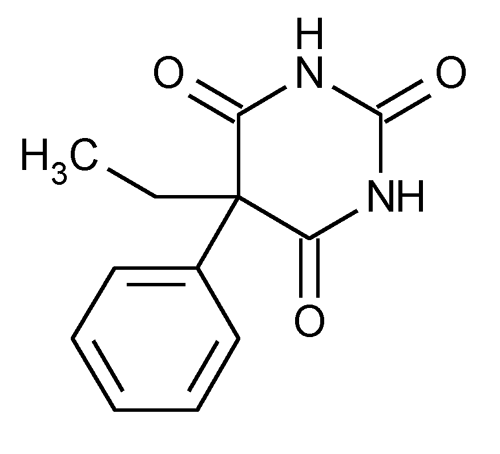Phenobarbital
2,4,6(1H,3H,5H)-Pyrimidinetrione, 5-ethyl-5-phenyl-.
5-Ethyl-5-phenylbarbituric acid
» Phenobarbital contains not less than 98.0 percent and not more than 101.0 percent of C12H12N2O3, calculated on the dried basis.
Packaging and storage—
Preserve in well-closed containers.
Identification—
A:
The IR absorption spectrum of a potassium bromide dispersion of it exhibits maxima only at the same wavelengths as that of a similar preparation of USP Phenobarbital RS. If a difference appears, dissolve portions of both the test specimen and the USP Reference Standard in a suitable solvent, evaporate the solutions to dryness, and repeat the test on the residues.
B:
The retention time of the major peak in the chromatogram of the Assay preparation corresponds to that of the Standard preparation, both relative to the internal standard, as obtained in the Assay.
Melting range  741
741 :
between 174
:
between 174 and 178
and 178 , but the range between beginning and end of melting does not exceed 2
, but the range between beginning and end of melting does not exceed 2 .
.
Loss on drying  731
731 —
Dry it at 105
—
Dry it at 105 for 2 hours: it loses not more than 1.0% of its weight.
for 2 hours: it loses not more than 1.0% of its weight.
Residue on ignition  281
281 :
not more than 0.15%.
:
not more than 0.15%.
Assay—
pH 4.5 Buffer solution—
Dissolve about 6.6 g of sodium acetate trihydrate and 3.0 mL of glacial acetic acid in 1000 mL of water, and adjust, if necessary, with glacial acetic acid to a pH of 4.5 ± 0.1.
Mobile phase—
Prepare a filtered and degassed mixture of pH 4.5 Buffer solution and methanol (3:2), making adjustments if necessary (see System Suitability under Chromatography  621
621 ).
).
Internal standard solution—
Dissolve a sufficient quantity of caffeine in a mixture of methanol and pH 4.5 Buffer solution (1:1) to obtain a solution having a concentration of about 125 µg per mL.
Standard preparation—
Dissolve about 20 mg of USP Phenobarbital RS, accurately weighed, in 15.0 mL of Internal standard solution. Sonicate if necessary.
Assay preparation—
Transfer about 20 mg of Phenobarbital, accurately weighed, to a conical flask, add 15.0 mL of Internal standard solution, mix, and sonicate for 15 minutes. Filter through a membrane filter (0.5 µm or finer porosity) before use.
Chromatographic system (see Chromatography  621
621 )—
The liquid chromatograph is equipped with a 254-nm detector and a 4-mm × 25-cm column that contains packing L1. The flow rate is about 2 mL per minute. Chromatograph the Standard preparation, and record the peak responses as directed for Procedure: the resolution, R, between the analyte and the internal standard peaks is not less than 1.2, the tailing factor for the analyte and the internal standard peaks is not greater than 2.0, and the relative standard deviation for replicate injections is not more than 2.0%.
)—
The liquid chromatograph is equipped with a 254-nm detector and a 4-mm × 25-cm column that contains packing L1. The flow rate is about 2 mL per minute. Chromatograph the Standard preparation, and record the peak responses as directed for Procedure: the resolution, R, between the analyte and the internal standard peaks is not less than 1.2, the tailing factor for the analyte and the internal standard peaks is not greater than 2.0, and the relative standard deviation for replicate injections is not more than 2.0%.
Procedure—
Separately inject equal volumes (about 10 µL) of the Standard preparation and the Assay preparation into the chromatograph, record the chromatograms, and measure the responses for the major peaks. The relative retention times are about 0.6 for caffeine and 1.0 for phenobarbital. Calculate the quantity, in mg, of C12H12N2O3 in the portion of Phenobarbital taken by the formula:
W(RU / RS)
in which W is the weight, in mg, of USP Phenobarbital RS taken for the Standard preparation, and RU and RS are the peak response ratios obtained from the Assay preparation and the Standard preparation, respectively.
Auxiliary Information—
Please check for your question in the FAQs before contacting USP.
Chromatographic Column—
| Topic/Question | Contact | Expert Committee |
| Monograph | Ravi Ravichandran, Ph.D.
Senior Scientist 1-301-816-8330 |
(MDPP05) Monograph Development-Psychiatrics and Psychoactives |
| Reference Standards | Lili Wang, Technical Services Scientist 1-301-816-8129 RSTech@usp.org |
USP32–NF27 Page 3270
Pharmacopeial Forum: Volume No. 29(6) Page 1964
Chromatographic columns text is not derived from, and not part of, USP 32 or NF 27.
